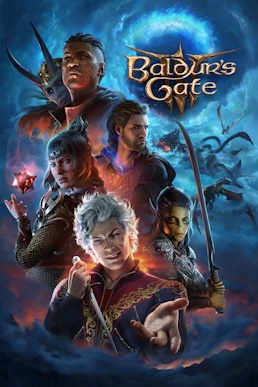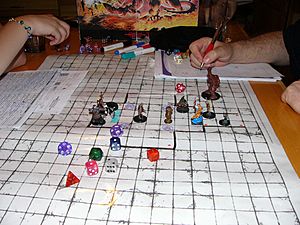Baldur's Gate 3 facts for kids
Quick facts for kids Baldur's Gate 3 |
|
|---|---|
 |
|
| Developer(s) | Larian Studios |
| Publisher(s) | Larian Studios |
| Director(s) | Swen Vincke |
| Producer(s) | David Walgrave |
| Programmer(s) | Bert Stevens |
| Artist(s) | Joachim Vleminckx |
| Writer(s) | Adam Smith |
| Composer(s) | Borislav Slavov |
| Series | Baldur's Gate |
| Platform(s) | |
| Release date(s) |
|
| Genre(s) | Role-playing |
| Mode(s) | Single-player, multiplayer |
Baldur's Gate 3 is a 2023 role-playing video game developed and published by Larian Studios. The game is the third main installment in the Baldur's Gate series, based on the tabletop role-playing system of Dungeons & Dragons. A partial version of the game was released in early access format for macOS and Windows on 6 October 2020. It remained in early access until its full release for Windows on 3 August 2023. The PlayStation 5 version was released on 6 September 2023, with the macOS version released shortly thereafter on 22 September. The Xbox Series X/S version released on 7 December 2023.
Baldur's Gate 3 received critical acclaim, with praise for its gameplay, narrative, and production quality. The game won multiple awards including the Golden Joystick Award for Game of the Year and The Game Award for Game of the Year.
Gameplay
Baldur's Gate 3 is a role-playing video game with single-player and cooperative multiplayer elements. Players can create one or more characters and form a party along with a number of pre-generated characters to explore the game's story. Optionally, players are able to take one of their characters and team up online with other players to form a party.
The game implements a flexible quest system with various approaches to resolving most quests. Players can eliminate almost any non-player character, regardless of their importance to the storyline, yet still continue to advance through the game. The game is divided into three acts, each taking place in a distinct region of the world. Within these acts, the game adopts an open-world format, permitting players to tackle quests in virtually any sequence.

Unlike previous games in the Baldur's Gate series, Baldur's Gate 3 has turn-based combat, similar to Larian's earlier games Divinity: Original Sin and Divinity: Original Sin II; all combat is based on the Dungeons & Dragons 5th Edition rules. Most mechanics and spells are taken from the tabletop role-playing game version of Dungeons & Dragons, although few are modified or omitted due to the adaptation of the game into a role-playing video game format. There are 12 character classes, which are further subdivided into 46 subclasses. Each class focuses on a different aspect of the combat system, such as a Wizard who focuses on spell casting a large variety of spells or a Barbarian who focuses on unarmoured melee combat. The player can also select more than one class per character, which is referred to as multiclassing, allowing the player to build their character in many different and unique ways.
The game incorporates a roster of 10 companion characters who are available for players to enlist in their party. Each of these characters has a personal story and a narrative that the player can explore further. The player can develop relationships with companion characters based on plot and dialogue choices made. Some of the companion characters are only accessible provided that the player makes specific plot or dialogue choices.
All characters, both major and minor, are fully voice acted and motion captured, amounting to approximately 1.5 million words of performance capture.
The game features a limited free floating camera, allowing the player to play the game in any camera ranging from fully third-person camera to an isometric top-down view. The game's user interface has both a mouse and keyboard and a controller mode. In both modes, the player can use spells and combat actions, manage inventory, see the map, display player and companion character's statistics and select various gameplay elements such as allied and enemy characters.
The game has modding support, although not all features and tools are available at launch, and modding options are expected to expand with subsequent updates. Many mods are available from the community, allowing the player to change various aspects of the game.
Plot
Setting
Baldur's Gate 3 takes place in the fictional world of the Forgotten Realms during the year of 1492 DR, over 120 years after the events of the previous game, Baldur's Gate II: Shadows of Amn, and months after the events of the playable Dungeons & Dragons 5e module, Baldur's Gate: Descent into Avernus. The story is set primarily in the Sword Coast in western Faerûn, encompassing a forested area that includes the Emerald Grove, a druid grove dedicated to the deity Silvanus; Moonrise Towers and the Shadow-Cursed Lands, which are covered by an unnatural and sentient darkness that can only be penetrated through magical means; and Baldur's Gate, the largest and most affluent city in the region, as well as its outlying suburb of Rivington. Other places the player will pass through include the Underdark, the Astral Plane and Avernus.
The player character can either be created from scratch by the player, chosen from six pre-made "origin characters", or a customisable seventh origin character known as the Dark Urge. All six pre-made origin characters can be recruited as part of the player character's party. They include Lae'zel, a githyanki fighter; Shadowheart, a half-elf cleric; Astarion, a high elf vampire rogue; Gale, a human wizard; Wyll, a human warlock; and Karlach, a tiefling barbarian. Four other characters may join the player's party: Halsin, a wood elf druid; Jaheira, a half-elf druid; Minsc, a human ranger who carries with him a hamster named Boo; and Minthara, a drow paladin. Jaheira and Minsc previously appeared in both Baldur's Gate and Baldur's Gate II: Shadows of Amn.
Story
The protagonist wakes up inside a giant dimension-crossing illithid (mind flayer) flying ship. They are implanted with an illithid tadpole, a parasite that enthrals and transforms people into illithids; however, the transformation does not happen, and the ship comes under attack from githyanki warriors. The protagonist is freed during the fighting and steers the damaged ship to Faerûn, where it crashes. They encounter other survivors of the wreck, all likewise implanted with tadpoles.
The party seeks to remove their parasites through numerous avenues, all of which fail to provide a cure. They are saved from the tadpoles' overwhelming psychic force by a "Dream Visitor" inside Shadowheart's mysterious prism, a device that is sought after by the githyanki. The protagonist then becomes involved in the fate of the Emerald Grove, where local druids and tiefling refugees face off against the goblin horde from the desecrated Selûnite temple nearby. Once the party either sacks or saves the grove, they travel through the mountains or the Underdark to reach Moonrise Towers in search of a new cure.
The protagonist seeks sanctuary from the curse around Moonrise Towers in a tavern called the Last Light, held by a group of tiefling refugees, Flaming Fist conscripts and Harpers, led by Jaheira. The party scours the depths of Moonrise in pursuit of the "Nightsong", revealed to be Dame Aylin, a daughter of Selûne. General Ketheric Thorm, the reigning lord of Moonrise and Chosen of Myrkul, has imprisoned Aylin and used her as an engine for his immortality. The player is given the choice to slay or free the Nightsong. The party ultimately confronts Ketheric, as well as his cohorts — Orin the Red, the Chosen of Bhaal and Enver Gortash, the Chosen of Bane. Through their Netherstones and a mysterious crown, the triumvirate collectively controls the Absolute, revealed to be an Elder Brain, the ultimate form of the illithid race, and seeks to rule the Sword Coast by manipulating everyone implanted with a tadpole. Orin and Gortash depart with the Elder Brain for Baldur's Gate, while the protagonist defeats Ketheric and claims his Netherstone.
The protagonist arrives at Baldur's Gate as Gortash and Orin attempt to pit them against the other, while the companions find closure for their personal quests. It is revealed that the "Dream Visitor" is, in fact, a visage taken by a renegade illithid called the Emperor, who resides within the prism and oversees the imprisonment of a powerful githyanki, Orpheus. Orpheus is the source of psionic resistance the party possesses against the Absolute, and the Emperor has been leveraging this in his favour. The protagonist eventually faces off against Gortash and Orin, assembling the Netherstones to subdue the Elder Brain. The Elder Brain, having anticipated the triumvirate and the protagonist's every move, overpowers the party before the Emperor comes to the rescue.
Realising that the Netherstones require an illithid wielder with Orpheus' powers to be effective, the protagonist either frees Orpheus and allows him to transform, which causes the Emperor to resign to his fate and join the Absolute, or has either the Emperor, a transformed Karlach or the player character consume Orpheus in order to see the mission through. After defeating the Elder Brain, the protagonist can choose to either kill it and every illithid tadpole with it, ending the threat forever, or betray their comrades and rule as the Absolute.
In a post-credit scene, Withers, a Wight who has watch over the party throughout the journey, returns to his tomb but not before taunting over the mural of Bhaal, Bane, and Myrkul regarding their failures and how they were bested by mortals such as the protagonist.
Development

The original Baldur's Gate game was developed by BioWare and Black Isle Studios, and published by Interplay Entertainment in 1998. The game used a licensed version of the Dungeons & Dragons (D&D) rule set, specifically in the Forgotten Realms setting. The game's success led to a sequel, Baldur's Gate II: Shadows of Amn, and its expansion pack, as well as the Icewind Dale series and Planescape: Torment. After the success of the spinoff Baldur's Gate: Dark Alliance by Snowblind Studios, Interplay announced plans to produce further sequels to the Baldur's Gate series. A planned sequel developed by Black Isle Studios, Baldur's Gate III: The Black Hound, was cancelled in 2003. Black Isle Studios would develop Baldur's Gate: Dark Alliance II before being shut down by Interplay in December 2003. Further development on the series was halted due to a lawsuit between Interplay and Snowblind over the rights to the Dark Alliance trademark, and the Baldur's Gate trademark would revert to Atari.
Atari would publish Neverwinter Nights, developed by BioWare, in 2002 and Neverwinter Nights 2, developed by Obsidian Entertainment, founded by former members of Black Isle Studios, in 2007. After the release of Neverwinter Nights 2, Obsidian Entertainment founder Feargus Urquhart unsuccessfully approached Atari to develop a sequel to Baldur's Gate. Further attempts to develop a new Baldur's Gate were made by Brian Fargo, the founder of both Interplay and inXile Entertainment, as well as Beamdog, developers of enhanced ports of the original games and the standalone expansion Baldur's Gate: Siege of Dragonspear.
Larian Studios were interested in making a sequel in the Baldur's Gate series for some time, having first approached Wizards of the Coast after their release of Divinity: Original Sin around 2014. At this time, Wizards of the Coast felt the studio was still too new to the industry to be trusted with the Baldur's Gate license. Larian then developed Divinity: Original Sin II, which was released in September 2017. Pre-release materials related to the game impressed Wizards of the Coast, so they contacted Larian to ask if they still had interest in Baldur's Gate 3. Larian accepted, and while working to wrap up the release stage of development for Divinity: Original Sin II, a small group gathered to develop the design document to present to Wizards of the Coast with their ideas for the new Baldur's Gate.

The game is based on the 5th-edition Dungeons & Dragons rule set, though it includes tweaks and modifications that Larian found necessary in adapting it to a video game. For example, the combat system is more in favour of the player than in the tabletop version, to make the game more enjoyable.
Larian Studios teased Baldur's Gate 3 in the week prior to E3 2019. They formally revealed it during Google's presentation on the Stadia platform just ahead of E3, confirming its release for both Windows and Stadia. The tabletop adventure Baldur's Gate: Descent Into Avernus was published by Wizards of the Coast in September 2019, and has been described as a "prequel" to Baldur's Gate 3. The Descent into Avernus adventure takes place roughly 100 years after the events of Baldur's Gate II, and the story of Baldur's Gate 3 takes place immediately following the events of the Descent into Avernus tabletop module. On 5 October 2020, Larian Studios announced the game would be released for macOS in addition to Windows and Stadia.
Early access
Baldur's Gate III was originally set to be released in early access on 30 September 2020. This date was later delayed to 6 October 2020. The early access version contained only the first act of the game, amounting to approximately 25 hours of content and one-fifth of the game world's map. The character creator also initially included a selection of 16 races and six classes from which to choose, with more planned for the final release. Additional features and content, including multiplayer functionality and more classes, were gradually added to the early access version through patches as development progressed towards the final release. Save files created during early access are not transferable to the completed game.
The game remained in early access until its release in August 2023. Following Stadia's closure on 18 January 2023, the full version for Stadia was cancelled. On 23 February 2023, it was announced that Baldur's Gate 3 would be fully released on 31 August 2023 for macOS, Windows, and PlayStation 5. A later announcement amended the PC release date to 3 August, and the macOS and PlayStation 5's to 6 September. A macOS version of the game was eventually released on 22 September 2023. An Xbox Series X and Series S port was confirmed by Larian to be in development, but was not officially announced as it ran into technical difficulties with split-screen co-op on the Series S; Microsoft had desired that all games released on the Xbox Series X and Series S had full feature parity. Larian mentioned that the game is not a PlayStation console exclusive and might get released on Xbox should the issues get fixed. The Xbox release was confirmed in August 2023, after Larian received an exclusive exception for the difference in features between the Series X and Series S consoles from Microsoft, allowing them to remove split-screen support on the lower-powered Series S version. Spike Chunsoft published the PlayStation 5 version in Japan.
Post-release
Gameplay features like the Magic Mirror, allowing users to change their character's appearance, were added with patches after release. Patch 5 added two new difficulty modes, quality of life enhancements, and a new playable epilogue containing 3589 new dialogue lines to ensure that the ending is reactive to the player's previous choices.
A physical release is planned for early 2024.
Awards
| Date | Award | Category | Recipient(s) | Result | Ref. |
|---|---|---|---|---|---|
| 2020 | 11th Hollywood Music in Media Awards | Original Song — Video Game | Borislav Slavov (for "Weeping Dawn") | Nominated | |
| 2021 | 12th Hollywood Music in Media Awards | Original Song — Video Game | Borislav Slavov (for "I Want to Live") | Nominated | |
| 2023 | Golden Joystick Awards | Best Storytelling | Baldur's Gate 3 | Won | |
| Best Game Community | Won | ||||
| Best Visual Design | Won | ||||
| PC Game of the Year | Won | ||||
| Studio of the Year | Larian Studios | Won | |||
| Best Supporting Performer | Amelia Tyler (Narrator) | Nominated | |||
| Neil Newbon (Astarion) | Won | ||||
| Ultimate Game of the Year | Baldur's Gate 3 | Won | |||
| 14th Hollywood Music in Media Awards | Original Score — Video Game | Borislav Slavov | Nominated | ||
| The Game Awards 2023 | Game of the Year | Baldur's Gate 3 | Won | ||
| Best Game Direction | Nominated | ||||
| Best Narrative | Nominated | ||||
| Best Community Support | Won | ||||
| Best Roleplaying Game | Won | ||||
| Best Multiplayer Game | Won | ||||
| Player's Voice | Won | ||||
| Best Score and Music | Borislav Slavov | Nominated | |||
| Best Performance | Neil Newbon | Won |
See also
 In Spanish: Baldur's Gate III para niños
In Spanish: Baldur's Gate III para niños

